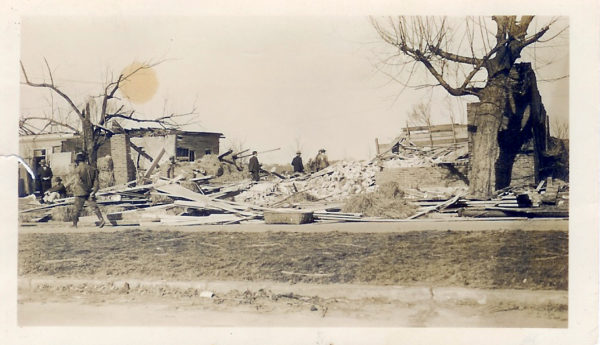The March 21, 1932 Outbreak: Northport

Photo from Jean Butterworth’s collection of the damage at Northport.
By mid-afternoon, the first wave of tornadoes was well underway over West Alabama. One of the biggest disasters of the day occurred from storms that had impacted parts of Hale and Marengo Counties.
The fourth tornado of the afternoon on that fateful day touched down from an ominous sky near Ralph, in Tuscaloosa County around 4 p.m. It passed across the western northwestern edge of Tuscaloosa. It heavily damaged the Tuscaloosa Country club before veering across the Warrior River. The violent twister then set its sights on the town of Northport.
Northport had a population on 2,173 in 1932. Part of the Warrior River basin, the bottomlands were used for pasture, but the grayish brown soil produced prolific crops of cotton, corn, oats and sugarcane.
The tornado destroyed a cotton gin and livery stable as it passed near the north end of the Warrior River Bridge. It narrowly missed the business district of Northport as it roared down Bridge Avenue. It then plowed down Watermelon Avenue, destroying houses on both sides of the road. Eyewitnesses said they heard the storm before they saw it, with the familiar locomotive sound. One woman saw it coming over the river from her porch. She said it “looked like a big ball of fire with smoke boiling all around it. Planks and sheet tin from parts of roofs were sailing all about it.” Within minutes, the bridge from Tuscaloosa was sealed off and only rescuers were permitted into the ravaged area.
Shortly after the disaster, an American Airways plane traveling from Fort Worth to Atlanta by way of Jackson passed over the stricken area. Herbert Kindred, the pilot, said that as they flew between Philadelphia, MS and Tuscaloosa, they encountered a very severe storm. They dropped to a low altitude to escape the bucking headwinds that made it difficult for him and his co-pilot to hold their seats. Fortunately, they had no passengers on board, as the last ones had disembarked in the Mississippi capital. As they flew low over Northport at an altitude of about 600 feet, they saw 200-300 buildings in ruins. Two buildings were on fire. Power was out to the entire city. There was a steady stream of cars coming across the river from Tuscaloosa.
Heavy rain and high winds hampered rescue efforts after the tornado. Rescuer worked by flashlight and lantern in the darkness. Private homes and University Buildings were pressed into service as hospitals. The darkness was pierced by ambulance sirens. About 8 p.m., an eerie scene developed as the clouds lifted and moonlight from a full moon bathed the disaster scene. The final toll along the probable F4 tornado’s 20 mile path was 37 people. Two hundred people were injured.
Category: ALL POSTS, Met 101/Weather History















